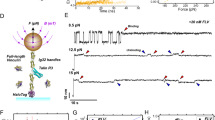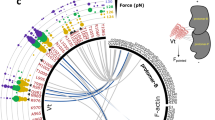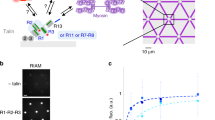Abstract
Vinculin is a conserved component and an essential regulator of both cell–cell (cadherin-mediated) and cell–matrix (integrin–talin-mediated focal adhesions) junctions, and it anchors these adhesion complexes to the actin cytoskeleton by binding to talin in integrin complexes or to α-actinin in cadherin junctions1,2,3. In its resting state, vinculin is held in a closed conformation through interactions between its head (Vh) and tail (Vt) domains4,5,6. The binding of vinculin to focal adhesions requires its association with talin. Here we report the crystal structures of human vinculin in its inactive and talin-activated states. Talin binding induces marked conformational changes in Vh, creating a novel helical bundle structure, and this alteration actively displaces Vt from Vh. These results, as well as the ability of α-actinin to also bind to Vh and displace Vt from pre-existing Vh–Vt complexes, support a model whereby Vh functions as a domain that undergoes marked structural changes that allow vinculin to direct cytoskeletal assembly in focal adhesions and adherens junctions. Notably, talin's effects on Vh structure establish helical bundle conversion as a signalling mechanism by which proteins direct cellular responses.
This is a preview of subscription content, access via your institution
Access options
Subscribe to this journal
Receive 51 print issues and online access
$199.00 per year
only $3.90 per issue
Buy this article
- Purchase on Springer Link
- Instant access to full article PDF
Prices may be subject to local taxes which are calculated during checkout





Similar content being viewed by others
References
Zamir, E. & Geiger, B. Molecular complexity and dynamics of cell-matrix adhesions. J. Cell Sci. 114, 3583–3590 (2001)
Pokutta, S. & Weis, W. I. The cytoplasmic face of cell contact sites. Curr. Opin. Struct. Biol. 12, 255–262 (2002)
Xu, W., Baribault, H. & Adamson, E. D. Vinculin knockout results in heart and brain defects during embryonic development. Development 125, 327–337 (1998)
Winkler, J., Lunsdorf, H. & Jockusch, B. M. The ultrastructure of chicken gizzard vinculin as visualized by high-resolution electron microscopy. J. Struct. Biol. 116, 270–277 (1996)
Gilmore, A. P. & Burridge, K. Regulation of vinculin binding to talin and actin by phosphatidyl-inositol-4–5-bisphosphate. Nature 381, 531–535 (1996)
Miller, G. J., Dunn, S. D. & Ball, E. H. Interaction of the N- and C-terminal domains of vinculin. Characterization and mapping studies. J. Biol. Chem. 276, 11729–11734 (2001)
McGregor, A., Blanchard, A. D., Rowe, A. J. & Critchley, D. R. Identification of the vinculin-binding site in the cytoskeletal protein α-actinin. Biochem. J. 301, 225–233 (1994)
Johnson, R. P. & Craig, S. W. F-actin binding site masked by the intramolecular association of vinculin head and tail domains. Nature 373, 261–264 (1995)
Wood, C. K., Turner, C. E., Jackson, P. & Critchley, D. R. Characterization of the paxillin-binding site and the C-terminal focal adhesion targeting sequence in vinculin. J. Cell Sci. 107, 709–717 (1994)
Bakolitsa, C., de Pereda, J. M., Bagshaw, C. R., Critchley, D. R. & Liddington, R. C. Crystal structure of the vinculin tail suggests a pathway for activation. Cell 99, 603–613 (1999)
Bass, M. D., Smith, B. J., Prigent, S. A. & Critchley, D. R. Talin contains three similar vinculin-binding sites predicted to form an amphipathic helix. Biochem. J. 341, 257–263 (1999)
Ling, K., Doughman, R. L., Firestone, A. J., Bunce, M. W. & Anderson, R. A. Type I gamma phosphatidylinositol phosphate kinase targets and regulates focal adhesions. Nature 420, 89–93 (2002)
Di Paolo, G. et al. Recruitment and regulation of phosphatidylinositol phosphate kinase type 1 gamma by the FERM domain of talin. Nature 420, 85–89 (2002)
Pokutta, S. & Weiss, W. I. Structure of the dimerization and β-catenin-binding region of α-catenin. Mol. Cell 5, 533–543 (2000)
Yang, J., Dokurno, P., Tonks, N. K. & Barford, D. Crystal structure of the M-fragment of α-catenin: implications for modulation of cell adhesion. EMBO J. 20, 3645–3656 (2001)
Pokutta, S., Drees, F., Takai, Y., Nelson, W. J. & Weis, W. I. Biochemical and structural definition of the l-afadin- and actin-binding sites of α-catenin. J. Biol. Chem. 277, 18868–18874 (2002)
Weiss, E. E., Kroemker, M., Rudiger, A.-H., Jockusch, B. M. & Rudiger, M. Vinculin is part of the cadherin-catenin junctional complex: complex formation between α-catenin and vinculin. J. Cell Biol. 131, 755–764 (1997)
Watabe-Uchida, M. et al. α-catenin-vinculin interaction functions to organize the apical junctional complex in epithelial cells. J. Cell Biol. 142, 847–857 (1998)
Johnson, R. P. & Craig, S. W. An intramolecular association between the head and tail domains of vinculin modulates talin binding. J. Biol. Chem. 269, 12611–12619 (1994)
Bass, M. D. et al. Further characterization of the interaction between the cytoskeletal proteins talin and vinculin. Biochem. J. 362, 761–768 (2002)
Lawrence, M. C. & Colman, P. M. Shape complementarity at protein/protein interfaces. J. Mol. Biol. 234, 946–950 (1993)
Johnson, R. P. & Craig, S. W. An intramolecular association between the head and tail domains of vinculin modulates talin binding. J. Biol. Chem. 269, 12611–12619 (1994)
Hayashi, I., Vuori, K. & Liddington, R. C. The focal adhesion targeting (FAT) region of focal adhesion kinase is a four-helical bundle that binds paxillin. Nature Struct. Biol. 9, 101–106 (2002)
Hoellerer, M. K. et al. Molecular recognition of paxillin LD motifs by focal adhesion targeting domain. Structure 11, 1207–1217 (2003)
Acknowledgements
We thank J. Cleveland for many helpful discussions. We also thank V. Morris, K. Brown and C. Kirby for technical assistance; C. Vonrhein for expert advice and help with autoSHARP; C. Ross for maintaining the X-ray and computing facilities; L. Messerle for the tantalum compound; and M. Kastan for critical review of the manuscript. We are grateful to the staff at the Advanced Photon Source, COM-CAT, SBC-CAT and SER-CAT, and at the Advanced Light Source, Lawrence Berkeley Laboratory, 5.0.2, for synchrotron support. This work was supported in part by the Cancer Center Support (CORE) Grant and by the American Lebanese Syrian Associated Charities (ALSAC). P.B. is a Van Vleet Fellow.
Author information
Authors and Affiliations
Corresponding author
Ethics declarations
Competing interests
The authors declare that they have no competing financial interests.
Supplementary information
41586_2004_BFnature02281_MOESM10_ESM.doc
Supplementary Table 2: Vh residues interacting with talin VBS3 residues as seen in the Vh:VBS3 crystal structure. (DOC 31 kb)
Rights and permissions
About this article
Cite this article
Izard, T., Evans, G., Borgon, R. et al. Vinculin activation by talin through helical bundle conversion. Nature 427, 171–175 (2004). https://doi.org/10.1038/nature02281
Received:
Accepted:
Published:
Issue Date:
DOI: https://doi.org/10.1038/nature02281
This article is cited by
-
Segmentation strategy of de novo designed four-helical bundles expands protein oligomerization modalities for cell regulation
Nature Communications (2023)
-
Remodeling of the focal adhesion complex by hydrogen-peroxide-induced senescence
Scientific Reports (2023)
-
Allosteric activation of vinculin by talin
Nature Communications (2023)
-
Complete Model of Vinculin Suggests the Mechanism of Activation by Helical Super-Bundle Unfurling
The Protein Journal (2022)
-
miRNA-200c-3p targets talin-1 to regulate integrin-mediated cell adhesion
Scientific Reports (2021)
Comments
By submitting a comment you agree to abide by our Terms and Community Guidelines. If you find something abusive or that does not comply with our terms or guidelines please flag it as inappropriate.



